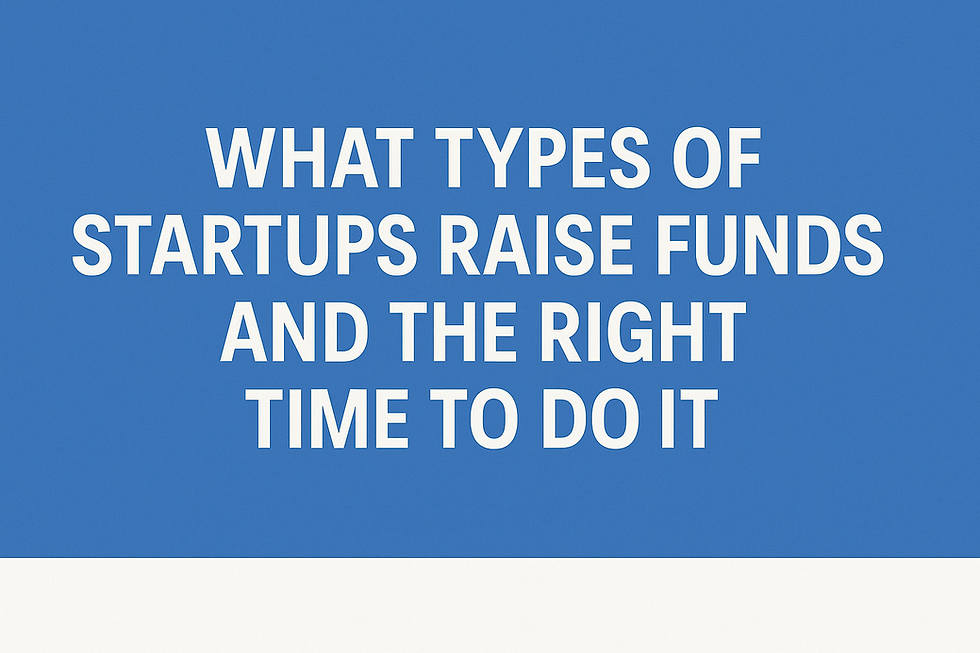Seed Funding Guide for Startup Founders (2025)
- Awake Partners

- Aug 14
- 4 min read
Updated: Aug 19
TL;DR — Seed funding in 2025:
• Raise when you have MVP + early traction and capital accelerates growth.
• Standard round size: typically $500k–$3M (varies by sector/region).
• Essentials: pitch deck, financial model (12–24 months), clean cap table, investor-ready Data Room.
• Goal: reach milestones for a strong Series A within 12–24 months.
This 2025 Seed funding guide walks startup founders through each step of the fundraising process — from pitch preparation to investor closing — with actionable tips and proven strategies from Awake Partners’ experience in global startup financing.
What Is Seed Funding?

Seed funding is the first significant capital injection your startup receives from external investors, typically after an initial bootstrapping or pre-seed phase. It bridges the gap between idea validation and scaling, giving you the resources to hire talent, develop your product, and test your go-to-market strategy.
Seed rounds often range from $500K to $5M, depending on your sector and geography. Investors may include business angels, early-stage VCs, corporate venture arms, or even Family Offices.
Understanding that Seed funding is not “free money” is key — you’ll be trading equity for capital, which means choosing investors who bring strategic value beyond cash.
When to Raise a Seed Round
Timing matters as much as the amount you raise.
You should consider raising a Seed round when:
You have a validated MVP and early traction (paying customers, pilots, or strong waitlist).
You can clearly articulate your market opportunity and competitive edge.
Additional capital would significantly accelerate growth, not just extend runway.
Raising too early risks giving away equity at a low valuation; too late, and you may miss market opportunities or lose momentum.
As Y Combinator points out in its Startup Library, raising too early can harm valuation and founder control.
A well-timed Seed round positions you for a stronger Series A in 12–24 months.
Seed Funding Preparation — Documents & Data
Investors expect rigorous preparation before committing. At minimum, you’ll need:
Pitch deck (problem, solution, traction, business model, team, financials).
Financial model (12–24 month forecast with clear assumptions).
Cap table (current shareholders and equity structure).
According to Carta’s cap table management guide, inconsistent equity records are one of the top diligence red flags.
Data room (due diligence-ready: legal docs, IP, contracts, KPIs).Data consistency is critical — any mismatch between your deck, model, and legal docs can erode trust.
Pro tip: Start building your data room early; it signals professionalism and speeds up due diligence.
Approaching and Selecting Investors
Not all investors are the right fit.

Research: Use databases like Crunchbase, PitchBook, or AngelList to identify active Seed investors in your sector.
Warm introductions: Leverage your network or investment banks like Awake Partners for intros.
Strategic fit: Beyond capital, assess whether they bring relevant industry experience, customer introductions, or geographic reach.
Approaching investors blindly with generic pitches rarely works. Tailor each outreach, referencing why your startup matches their portfolio strategy.
As highlighted in TechCrunch’s coverage of early-stage fundraising, many successful Seed rounds hinge on storytelling and trusted introductions.
Negotiating Terms and Closing the Deal
Once you have term sheets, don’t rush. Key terms include:
Valuation and equity percentage.
Liquidation preferences (how proceeds are distributed in an exit).
Investor rights (board seats, information rights, veto powers).
Negotiate with both the short-term and long-term in mind — a “bad” term can hinder future rounds.
Work with an experienced startup lawyer to review documents. Closing is not just signing; it’s also fulfilling all conditions precedent before funds are transferred.
Common Mistakes to Avoid
Overestimating your valuation without traction to back it up.
Underestimating the time required (3–6 months is common).
Ignoring the cultural fit with investors.
Failing to maintain regular updates post-investment.
Avoiding these pitfalls increases your credibility and smooths future fundraising.
Key takeaways
• Seed = trade equity for capital + strategic value.
• Timing matters more than amount; don’t raise without clear milestones.
• Data consistency across deck/model/docs builds trust and speeds diligence.
How Awake Partners Can Help You Raise Seed Funding
With experience in Pre-Seed, Seed, and Series A fundraising across Europe, APAC, and the US, Awake Partners helps founders:
Refine their pitch and financial model.
Connect with strategic investors.
Navigate negotiations and close effectively.
We’ve supported startups in deeptech, health, and impact to secure funding faster and on better terms.
Once you’ve successfully closed your Seed round, our Series A Funding Guide will help you prepare for the next stage.
Q&A — Quick answers for founders
Q: What is Seed funding?
A: The first significant external capital to prove scalable growth (hire, product, GTM).
Q: When should I raise a Seed round?
A: Once you show MVP + early traction and have a clear plan to accelerate growth with capital.
Q: What documents do investors expect at Seed?
A: Pitch deck, 12–24 month financial model, cap table, and a due‑diligence Data Room.
Q: Typical Seed round size?
A: Often $500k–$3M, but ranges vary by sector, geography, and traction.
By Awake Partners — updated Aug 2025



